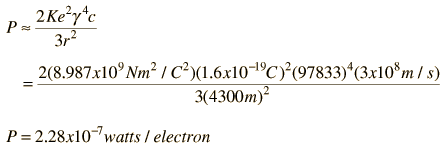Synchrotron Radiation
Synchrotron radiation is the name given to the radiation which occurs when charged particles are accelerated in a curved path or orbit. Classically, any charged particle which moves in a curved path or is accelerated in a straight-line path will emit electromagnetic radiation. Various names are given to this radiation in different contexts. For example, when is occurs upon electron impact with a solid metal target in an x-ray tube, it is called "brehmsstrahlung" radiation.
Particularly in the application to circular particle accelerators like synchrotrons, where charged particles are accelerated to very high speeds, the radiation is referred to as synchrotron radiation. This radiated energy is proportional to the fourth power of the particle speed and is inversely proportional to the square of the radius of the path. It becomes the limiting factor on the final energy of particles accelerated in electron synchrotrons like the LEP at CERN. In other contexts like the detector arrays in accelerators, it can be detected and used as an aid to analyzing the products of the scattering event in the accelerator.
The classical formula for the radiated power from an accelerated electron is

For a non-relativistic circular orbit, the acceleration is just the centripetal acceleration, v2/r. The orbits of interest in accelerators are highly relativistic, so the relativistic acceleration can be gotten from

where

and m is the rest mass of the particle and the time rate of change of g is neglected. That assumption really needs to be defended more rigorously*, but it appears that the v4 term should dominate. The radiated power is then

Since the velocity becomes nearly constant for highly relativistic particles, the term g4 becomes the dominate variable in determining loss rate. This means that the loss scales as the fourth power of the particle energy gmc2. For an accelerator like a synchrotron, the radius is fixed after construction, but the inverse dependence of synchrotron radiation loss on radius argues for building the accelerator as large as possible.
The LEP electron synchrotron has a rated energy of 50 GeV and a radius of 4300 meters. This gives a relativistic gamma of about 98,000 compared to a gamma of 54 for a 50 GeV proton (see relativistic kinetic energy calculation). At that energy, the velocity is essentially c, so the synchrotron radiation power for a single electron can be calculated as follows:

Two-tenths of a microwatt may not sound like much loss, but per electron it is enormous! At this energy the proton velocity would also be essentially c, so the synchrotron radiation loss for the two particles scales like their gammas. So the loss rate for the electron is (97833/54)4 or over 1013 times the loss for a proton of the same energy in the same synchrotron.
The loss of energy per orbit can be calculated from

*At the high value of gamma associated with these electrons, it is not valid to leave out the velocity term in gamma if you are treating that velocity the same as the other velocity term. Applying the straight chain rule for differentiation would make the term with the derivative of gamma even larger than the other term. However, on physical grounds, the velocity in the gamma is that associated with the dynamical effects, and at a given speed around the circle, it is not changing with time. The term which gives v2/r is associated with the change in direction, and must be included.
Particle concepts
Reference
Rohlf
Ch 16
| HyperPhysics***** Quantum Physics | R Nave |